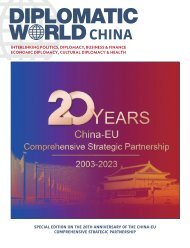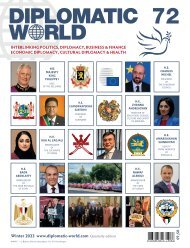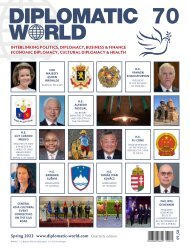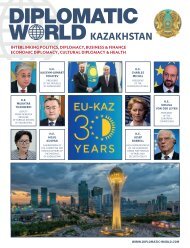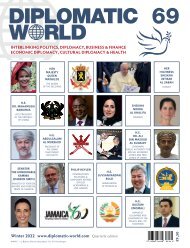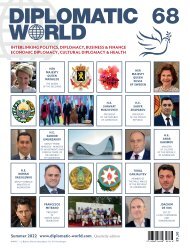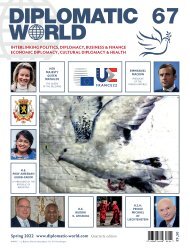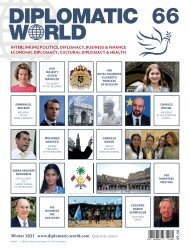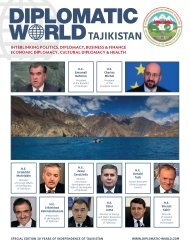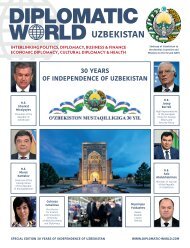Diplomatic World 67
You also want an ePaper? Increase the reach of your titles
YUMPU automatically turns print PDFs into web optimized ePapers that Google loves.
Vesta - Mechelse Cubalaya - CCP11, Seduzione. Koen Vanmechelen. Galleria degli Uffizi, 2022 Installation view, Medusa by Caravaggio (middle) and Koen Vanmechelen, Seduzione, Uffizi Galleries, 2022 Photo: Francesco Allegretto<br />
My installations are meant to encourage a Cosmopolitan Renaissance,<br />
developing new philosophies, ideas, and approaches that<br />
could herald new and better futures. Reason why, interspersed<br />
among Uffizi’s paintings and statues, you can find my Temptation<br />
sculptures: 15 marble busts inspired by the Classical sculptures<br />
of figures such as Augustus, Caesar, Hermes, Niobe, Plautilla,<br />
and Socrates. Emperors, philosophers, warriors, heroes, and<br />
divinities. They all carry a cracked glass egg from which hybrid<br />
creatures spring forth, representing the mind’s freeing and imagination.<br />
They create an evocative and disorienting journey around<br />
the idea of seduction, offering a kind of hymn to the power of life<br />
and the regenerating, although sometimes monstrous, force of<br />
the natural world.<br />
Another realisation hit me when I left the Uffizi the day before the<br />
official opening. Some museums might indeed risk becoming<br />
tombs, offering works without a context, masterpieces that have<br />
just become mere projections of the occasional visitor’s mindscape.<br />
Art always carries the generations and their contexts.<br />
Its meaning cannot be interpreted without knowing the nest it<br />
emerged from.<br />
I stopped at Caravaggio’s Medusa after lingering in front of works<br />
of Raphael, Michelangelo, and the Flemish Painters. The Medusa<br />
was made at the end of the 16th century. The start of science,<br />
of the world economy, of interconnectedness. People from the<br />
Middle East, Europe, Central, South and North America, Asia and<br />
Oceania connected with people from distant cultures. Wars of<br />
ideas were fought. It was the beginning of the Eurocentric and<br />
anthropocentric biases. But it was also a time when nature was<br />
in abundance, the wilderness was not tamed yet, and scientists<br />
in different places and cultures had different systems for naming<br />
life. Then, only a fraction of all the green growth on Earth was<br />
consumed by humans.<br />
One can only truly grasp the meaning of Caravaggio’s Medusa<br />
if one realises this was a time new narratives were being born<br />
and were flooding past ones, when a global movement of genes<br />
and memes was violently kickstarted, giving an opening to the<br />
creation of new worlds. As usual, creations always appear out of<br />
confrontations.<br />
The Renaissance was the start of the effort by humanity to<br />
control the unstoppable forces of nature. They chose not to work<br />
with the planet but to control it. Rob Dunn, in A Natural History of<br />
the Future, puts it like this: “We seek, collectively, to simplify the<br />
living world and channel it into our service, to circumscribe it so<br />
fully within our powers that it ceases even to be visible.”<br />
The Cosmopolitan Renaissance encourages a more loving and<br />
healing embrace of the broader natural ecosystem. This is a particularly<br />
salient and poignant point in the context of our ongoing<br />
pandemic, which is an urgent warning to what could follow.<br />
I quote Dunn again: “Even under the most optimistic scenarios,<br />
by the year 2080, hundreds of millions of species will need to<br />
migrate to new regions and even new continents to survive. We<br />
are reshaping nature at unprecedented scales, and for the most<br />
part, we are absentmindedly looking the other way while doing<br />
so.” Conclusion: we must reshape our minds and perspective<br />
in relation to the world. We have to make a new canvas for ourselves<br />
and the rest of life on our planet.<br />
The question then is: which painting would you like to live in?<br />
Or better yet: in which painting do we live? I remember a mysterious<br />
children’s book about a strange man who took refuge<br />
in a painting in times of need. How big was that other world he<br />
Vesta, Seduzione, Koen Vanmechelen, Uffizi Galleries, 2022<br />
Photo: Francesco Allegretto<br />
104 105





